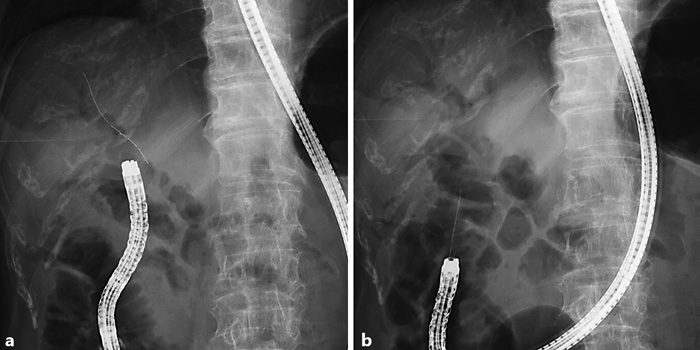A 71-year-old woman was referred to our department for epigastric fullness and discomfort lasting for a month. She underwent pancreatoduodenectomy (PD) with modified Child’s reconstruction and internal stenting across a pancreaticojejunostomy (PJ) 15 months earlier for distal bile duct cancer and had no recurrence or problem associated with the surgery in her follow-up. On admission, she had no leukocytosis, and her liver tests and pancreatic enzymes were within the normal range. Contrast-enhanced computed tomography showed the migration of the pancreatic stent into the intrahepatic bile duct with pneumobilia (Fig. 1). Although her liver tests remained normal, endoscopic retrieval using a single balloon enteroscope (SIF-H290S; Olympus Medical Systems, Tokyo, Japan) was performed, considering that her symptoms may have been associated with the migrated stent. Single balloon enteroscopy showed the migrated stent lying across the hepaticojejunal anastomosis, and furthermore, a bile duct ulcer due to the migrated stent was found at the right hepatic duct (Fig. 2). Endoscopic retrieval of the migrated stent was successfully achieved by using a snare under fluoroscopy (Fig. 3). The patient was discharged uneventfully, and her epigastric fullness and discomfort gradually ceased after the stent retrieval.

Fig. 1. a, b Contrast-enhanced computed tomography showed the migration of an internal pancreatic stent into the intrahepatic bile duct with pneumobilia (arrow).

Fig. 2. Single balloon enteroscopy showed a migrated pancreatic stent lying across the hepaticojejunal anastomosis (a) and a bile duct ulcer at the right hepatic duct (b).

Fig. 3. a, b Endoscopic retrieval of the migrated stent was successfully achieved by using a snare under fluoroscopy.
Postoperative pancreatic fistula remains the leading cause of morbidity after PD. Various management strategies have been proposed to reduce postoperative pancreatic fistula; the use of an internal stent with the PJ is a commonly used tactic for PD [1]. Although the internal stent placed across the PJ usually passes spontaneously through the rectum, endoscopic stent retrieval should be considered when an internal stent migrates [2]. The incidence of internal stent migration into the bile ducts following PD was reported to range from 7 to 16.8%, and these migrations were mostly subclinical [2-4]. To date, stent-induced complications including bile duct stricture, hepatolithiasis, and liver abscess have been noted in previous reports, and they usually involve changes in computed tomography findings or liver tests. This case suggests that bile duct ulcer should be included in the differential diagnosis in patients presenting with stent migration into the bile ducts after PD, even if the patients have normal liver tests.















